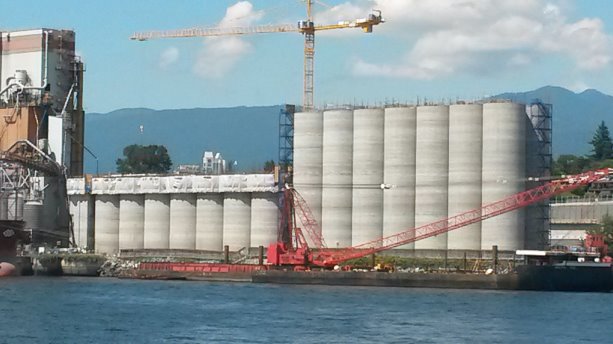Richardson’s Vancouver Terminal facility in North Vancouver is expanding at lightning speed last week as workers poured concrete 24 hours a day for its new storage facilities.
The method is known as slip form concrete casting. Douglas J. Petrick is the senior vice president of construction and design at FWS group, the company doing the work which specializes in the rapid pouring method. He said the North Vancouver project is by far the largest they have ever done using the method. It will roughly double the facility’s capacity by adding more than 80,000 metric tonnes of storage.
A our of this size takes about a week of around the clock pouring.
"It is by far the most preferred method of construction chosen by owners for any sort of material handling facilities," Petrick said. "And far superior to any other methods on the marketplace."
Petrick said his team spent nine months preparing for the east annex and west annex pours, the first of which happened earlier this year.
Once a pour starts, it can’t stop. Teams pour concrete 24 hours a day until the silo is completed. The advantage of the continuous pour is structural strength, Petrick explained. One pour means no seams or joints. The monolithic silo is stronger and far less likely to have leaks. Without it, joints would be required at about every four to eight feet.
Petrick said the method requires an army of roughly 500 people including 400 workers doing the casting on 12 hour shifts.
A platform system wrapped around the storage structure is powered by 400 synchronized jacks.
As it slowly crawls higher, about one inch every six minutes, workers must keep pace as they pump concrete and lay reinforcing steel.
Planning for the worst is key to making sure all goes smoothly.
"You must have so many redundancies in your system," Petrick said.
One of those issues is working in an unpredictable urban traffic environment. Materials and staff need to be on site and on time. Petrick said his team utilized backup travel routes as well as barges on the waterways to ensure this.
Reserve staffing and backup suppliers are also a must. Petrick said this came into play when one of the concrete plants suffered a system failure. Because his team already had a backup plant on standby throughout the entire pour, there was no delay and the pour continued. After about 24 hours of curing, the concrete is at about one-third its ultimate strength.
Winnipeg-based Richardson International Limited, Canada’s largest privately-owned agribusiness, began construction on the facility expansion last May and expects it to take two years to complete. The current terminal handles approximately three million metric tonnes of grain and oilseeds each year and is a major exporter of canola and cereal grains to countries along the Pacific Rim.
According to Richardson, global demand is growing and Richardson’s Vancouver Terminal is currently operating at maximum capacity. With changes to the Canadian Wheat Board and other changes in the Canadian grain industry, Richardson expects to handle in excess of five million metric tonnes of grains and oilseeds with additional storage capacity.
Richardson received a project permit from Port Metro Vancouver on April 2013.



Recent Comments
comments for this post are closed